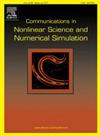IF 3.4
2区 数学
Q1 MATHEMATICS, APPLIED
Communications in Nonlinear Science and Numerical Simulation
Pub Date : 2025-04-01
DOI:10.1016/j.cnsns.2025.108792
引用次数: 0
摘要
本研究调查了临时俘获月球的机制,这种俘获要么来自周期轨道,要么遵循与日地系统天平动点动力学相关的反弹轨迹。主要目的是分析临时捕获所需的操纵,并探索在地月系统中自然临时捕获的可能性。我们首先定义一个临时捕获集,确定在近地点相对月球允许的最大偏心率,同时满足旋转约束。然后,利用适当的扩展,我们研究了从日地天平动点系统开始的临时捕获,重点是天平动点轨道的中心平面内振幅值。接下来,我们将扩展的双曲振幅包括在内,并探索在跃迁点轨道上反弹的临时捕获。最后,基于这些分析,我们提出了一种实现从地球出发的低能量自然俘获轨迹的方法。本文章由计算机程序翻译,如有差异,请以英文原文为准。
Temporary capture about the Moon involving Sun–Earth libration point dynamics
This study investigates the mechanism of temporary capture about the Moon, either originating from periodic orbits or following bounce-back trajectories associated with the libration point dynamics of the Sun–Earth system. The primary objective is to analyze the maneuvers required for temporary capture and to explore possibilities for natural temporary capture in the Earth–Moon system. We begin by defining a temporary capture set, determining the maximum eccentricity allowed at perigee with respect to the Moon while satisfying a revolution constraint. Then, using an appropriate expansion, we examine temporary capture initiated from the Sun–Earth libration point regime, focusing on the value of the central in-plane amplitude of the libration point orbits. Next, we include the hyperbolic amplitudes of the expansion and explore temporary capture with orbits that bounce back in the libration point regime. Finally, based on these analyses, we propose a method for achieving low-energy natural capture trajectories departing from the Earth.
求助全文
通过发布文献求助,成功后即可免费获取论文全文。
去求助
来源期刊

Communications in Nonlinear Science and Numerical Simulation
MATHEMATICS, APPLIED-MATHEMATICS, INTERDISCIPLINARY APPLICATIONS
CiteScore
6.80
自引率
7.70%
发文量
378
审稿时长
78 days
期刊介绍:
The journal publishes original research findings on experimental observation, mathematical modeling, theoretical analysis and numerical simulation, for more accurate description, better prediction or novel application, of nonlinear phenomena in science and engineering. It offers a venue for researchers to make rapid exchange of ideas and techniques in nonlinear science and complexity.
The submission of manuscripts with cross-disciplinary approaches in nonlinear science and complexity is particularly encouraged.
Topics of interest:
Nonlinear differential or delay equations, Lie group analysis and asymptotic methods, Discontinuous systems, Fractals, Fractional calculus and dynamics, Nonlinear effects in quantum mechanics, Nonlinear stochastic processes, Experimental nonlinear science, Time-series and signal analysis, Computational methods and simulations in nonlinear science and engineering, Control of dynamical systems, Synchronization, Lyapunov analysis, High-dimensional chaos and turbulence, Chaos in Hamiltonian systems, Integrable systems and solitons, Collective behavior in many-body systems, Biological physics and networks, Nonlinear mechanical systems, Complex systems and complexity.
No length limitation for contributions is set, but only concisely written manuscripts are published. Brief papers are published on the basis of Rapid Communications. Discussions of previously published papers are welcome.
 求助内容:
求助内容: 应助结果提醒方式:
应助结果提醒方式:


